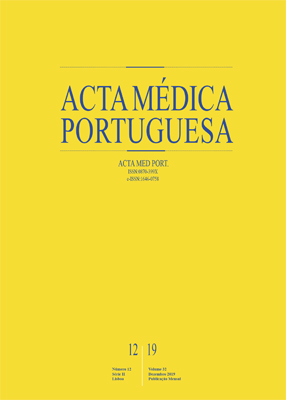Congenital or Early Acquired Deafness: An Overview of the Portuguese Situation, from Diagnosis to Follow-Up
DOI:
https://doi.org/10.20344/amp.11880Keywords:
Deafness/congenital, Deafness/diagnosis, Hearing Tests, Neonatal Screening, PortugalAbstract
Introduction: Congenital deafness or early acquired deafness affects 1 to 3 out of 1000 newborns without risk factors and 20 to 40 out of 1000 newborns with risk factors. The universal newborn hearing screening enables its early identification. Children with congenital deafness/early acquired deafness have a higher prevalence of other conditions, especially ophthalmologic and neurodevelopmental ones, and at least 30% to 40% have at least one associated comorbidity.
Material and Methods: We carried out a cross-sectional, multicenter study in which 83% (n = 30) of the hospitals/maternity hospitals of the National Health Service participated.
Results: All surveyed hospitals/maternity hospitals routinely performed universal newborn hearing screening to all newborns before discharge; 63% referred children with risk factors for hearing loss to Otorhinolaryngology. All children with congenital deafness/early acquired deafness are referred to: Pediatrics in 23% hospitals/maternity hospitals. In 23 hospitals/maternity hospitals, all children with congenital deafness/early acquired deafness are referred to: Speech Therapy in 44% hospitals/ maternity hospitals; Ophthalmology in 17% hospitals/maternity hospitals; National System of Early Intervention in Childhood in 30% hospitals/maternity hospitals; 22% of hospitals/maternity hospitals refer all children with congenital deafness/early acquired deafness, with no identified cause, to Clinical Genetics clinics. The number of diagnoses of deafness in the years 2014 and 2015 was 2.5 and 1.5 per 1000 newborns, respectively, in 15 hospitals/maternity hospitals.
Discussion: Awareness of universal newborn hearing screening seems to be widely spread in the National Health Service. The number of children with SC / SPA, as well as the percentage of different types of deafness diagnosed, were identical to those found in other studies and shows its importance. The assessment / follow-up of these children by specialties other than the otolaryngology was heterogeneous in different health entities and revealed that not all children with risk factors for deafness follow up advised by existing standards.
Conclusion: Results show that Portugal made an important path in the screening and follow-up of children with SC / SPA. It is important, with the ultimate aim of continually improving the care of these children, to reflect on the involvement of specialties other than otolaryngology, such as the National Early Childhood Intervention System in the follow-up of these children.
Downloads
Downloads
Published
How to Cite
Issue
Section
License
All the articles published in the AMP are open access and comply with the requirements of funding agencies or academic institutions. The AMP is governed by the terms of the Creative Commons ‘Attribution – Non-Commercial Use - (CC-BY-NC)’ license, regarding the use by third parties.
It is the author’s responsibility to obtain approval for the reproduction of figures, tables, etc. from other publications.
Upon acceptance of an article for publication, the authors will be asked to complete the ICMJE “Copyright Liability and Copyright Sharing Statement “(http://www.actamedicaportuguesa.com/info/AMP-NormasPublicacao.pdf) and the “Declaration of Potential Conflicts of Interest” (http:// www.icmje.org/conflicts-of-interest). An e-mail will be sent to the corresponding author to acknowledge receipt of the manuscript.
After publication, the authors are authorised to make their articles available in repositories of their institutions of origin, as long as they always mention where they were published and according to the Creative Commons license.









